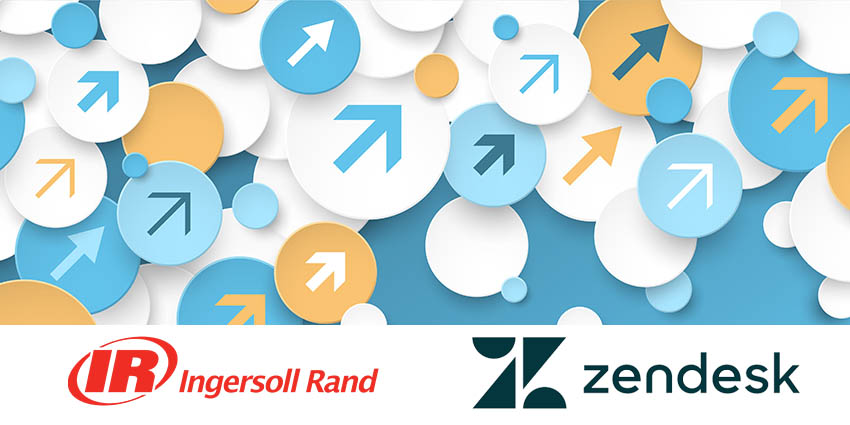Staying ahead of the competition in the retail industry means being ready to innovate and pivot rapidly to suit the needs of your audience. If any company understands the importance of agility in the retail and distribution landscape, it’s Ingersoll Rand.
If you’ve ever watched a NASCAR race, you’ll know how amazing it is to see the people in the pit crews using their specialised guns to remove lug nuts in seconds. These quick-change experiences wouldn’t be possible without companies like Ingersoll Rand, innovators in the production of sensational manufacturing tools.
For decades, Ingersoll Rand has been producing market-changing tools for its target audience. However, in recent years, the company decided product innovation wasn’t enough. The brand also needed to ensure it was staying up to date with CX transformations.
Here’s how Ingersoll Rand used Zendesk technology to upgrade its CX strategy.
Making the Transition to a New Age of CX
A glimpse at the importance of transitioning to the digital world even in a pre-pandemic landscape, the case study between Ingersoll Rand and Zendesk demonstrates how difficult it can be for bigger businesses to evolve.
From a product perspective, the company was used to producing state-of-the-art and cutting-edge tools for breweries, gas extraction, and wastewater treatment plans, not to mention the NASCAR landscape. Founded in 1871, the company started producing precision drilling tools for a range of consumers before gradually expanding into a global conglomerate. Today, Ingersoll Rand makes everything from power tools to air compressors.
Best known for its commitment to high-quality and reliable devices capable of lasting for years at a time, the business has built a strong relationship with a wide variety of buyers over the years. However, maintaining this relationship requires significant investment.
Currently, Ingersoll Rand distributes its products through a team of thousands of licensed distributors – dozens of which are also designated as repair centres. A combination of a broad global footprint and a wealth of new and legacy products meant when the age of digital transformation began to accelerate, both Ingersoll Rand and its distributors were struggling to stay ahead of the CX curve.
Making the Transition to Zendesk
Until 2014, the brand relied on Lotus Notes, followed by Microsoft Outlook, and neither tool met the company’s needs to deliver exceptional support. According to Global Customer Experience VP Kelly Dees, the tools they had at the time were too essential for their requirements.
Outlook couldn’t monitor response times and provided limited access to other insights. A desire to provide faster support and track results led the company to choose Zendesk technology to empower CX support teams.
The company began working with Zendesk when it was still a smaller company in 2014. They found it extremely useful for collaboration, and the features started to evolve over the years. According to Dees, every time she turned around, Zendesk was helping the brand grow.
With email accounting for about 90% of Ingersoll Rand’s support volume at the time, Zendesk proved to be a handy tool. Eventually, the retail company also used Zendesk to create voice tickets through integration with NICE InContact through the Zendesk API.
Gradually, Ingersoll Rand began implementing new API and integrations into the Zendesk ecosystem. They built a connection to UPS to help rapidly generate labels for warranty evaluation, returns and repair. Soon after, the company engaged in development with Zendesk APIs to build more extensive integrations, unifying various backend systems and simplifying the process of submitting warranty claims, communicating with repair agents, and ordering parts.
With greater context and more streamlined workflows, the support teams at Ingersoll Rand quickly increased their customer satisfaction rates by 35% over three years. The teams could also meet their 4-hour SLA on email tickets 95% of the time.
Upgrading Knowledge Management and Self-Service
After boosting ticket management, Ingersoll Rand focused on promoting knowledge management and enabling customers to be more self-sufficient. The products produced by the company are designed to last a long time. In fact, the brand still services some products that are more than 50 years old. In the past, the company didn’t have a central repository for storing all customer repair data. Navigating an outdated paper-based system was a drain on employee resources.
Moreover, manual processes also meant customers had to deal with significant waiting times. According to Ingersoll Rand, when distributors call, they look for answers immediately. In an ideal situation, many distributors are even looking for ways to find information themselves.
Zendesk technology allowed Ingersoll Rand to build a branded help centre for customers searching for self-service. The environment also has a library of digital manuals customers can download and leverage. The company has taken a slow but steady approach to publish help content online. What’s more, with customised help forms, they can provide customers with direct access to the articles they might need based on their requests.
According to Ingersoll Rand, the strategy is to take the more straightforward questions customers often have and answer them immediately in a help centre, so dedicated engineers have more time to focus on more complicated product support.
Driving Amazing Customer Experiences
Aside from improving the support centre for the company, Zendesk has helped Ingersoll Rand to understand customer and agent paint points more effectively. According to Dees, Zendesk has given the team much better visibility of incoming requests. Moreover, it allowed them to understand incoming requests and level load accounts.
The technology has even allowed Ingersoll Rand to see what types of requests distributors frequently ask, so they can uncover new training opportunities.
For instance, the company learned distributors recently emailed about tracking information. This insight led the company to revisit the order entry system and provide distributors with a screen where they could find information themselves. Today, Ingersoll Rand continues to grow with access to Zendesk.







